The Dell Venue 11 Pro 7000 Review
by Brett Howse on April 16, 2015 8:00 AM EST- Posted in
- Tablets
- Dell
- Windows 8.1
- Core M
Battery Life
Battery life is one of the critical elements to any mobile device, especially one such as a tablet. Notebooks can easily be used from desk to desk, but for a tablet, mobility is king. If it was not, you likely would not want a tablet.
The Venue 11 Pro is somewhat different in that it is a tablet first and foremost, but is also offered with a keyboard dock which basically turns it into a laptop. It offers Connected Standby support like other Windows tablets, but on the inside are parts which are more often found in Ultrabooks. For this reason both tablet battery life and laptop battery life was tested.
The Venue 11 Pro comes with an integrated 38 Wh battery. The keyboard dock includes an integrated battery as well which is around 24 Wh, so that combined the total is about 62 Wh of battery capacity.
As always, our devices are standardized to 200 nits of brightness for all battery life tests.
Tablet Battery Life
First off, the Venue 11 Pro needs to be tested as what it is – a tablet. For this we have tested the device with our tablet browsing test, which is less demanding than the one we use on laptops.
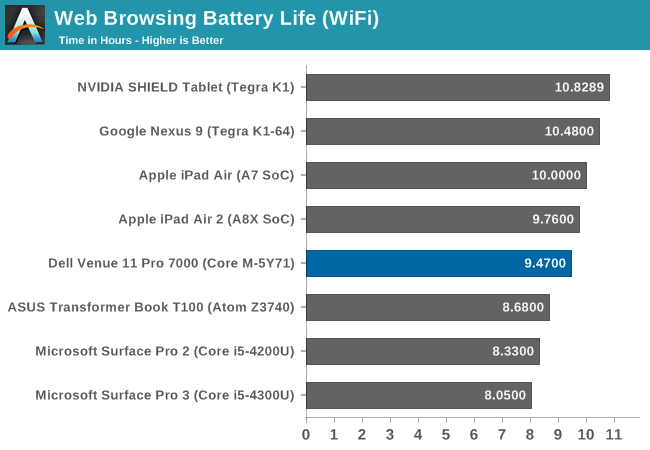
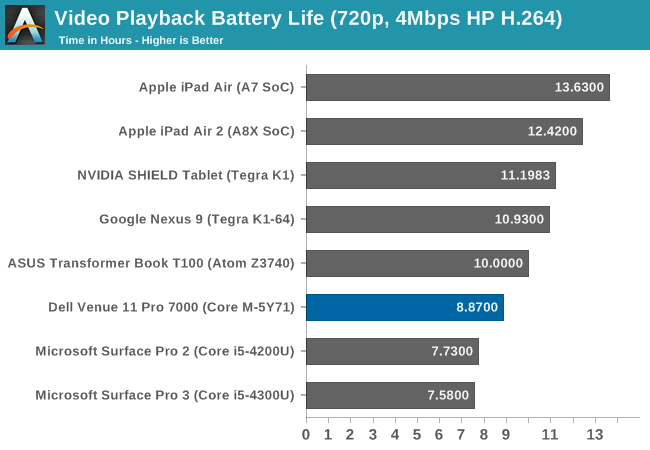
Tablet battery life is actually quite good, coming in just under the iPad Air 2 in our Wi-Fi test. It is of course helped by its much larger battery than the average tablet. For example, the iPad Air 2 has a 27.62 Wh battery versus 38 Wh in the Dell. Video playback time is not quite as impressive even though it does have hardware support for the video decode. The hardware and software for video playback on the ARM devices seems to be a bit more tuned. Tablets need to be mobile, so the Venue 11 Pro's larger battery helps it deliver competetive overall battery life.
Laptop Battery Life
When docked to the keyboard accessory, the tablet can be used as a laptop replacement. It is a very small laptop mind you, but it can be used this way if needed.
With Core M, a reasonable resolution, and a relatively big battery, hopes are that this unit will deliver on the battery front. As with our tablets, all battery testing is done at 200 nits to have a consistent performance level for the display, and for the notebook tests, the Dell Venue 11 Pro was docked to the Mobile Keyboard to increase the total battery size to 60 Wh.
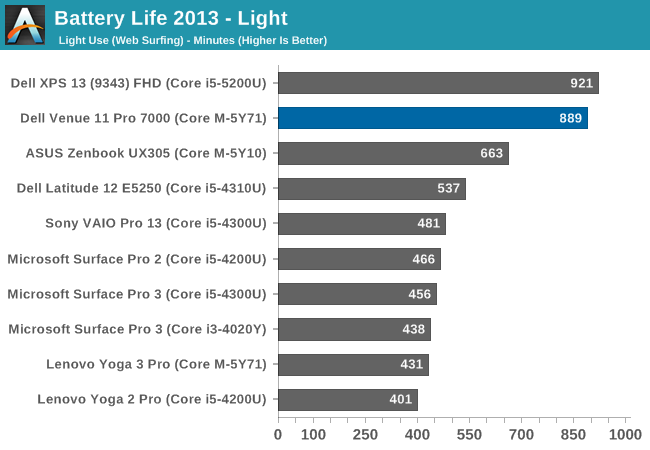
The Venue 11 Pro can deliver some pretty amazing battery life, coming in at almost fifteen hours of use. Not too many devices can deliver this on our light test, which consists of just web browsing over Wi-Fi.
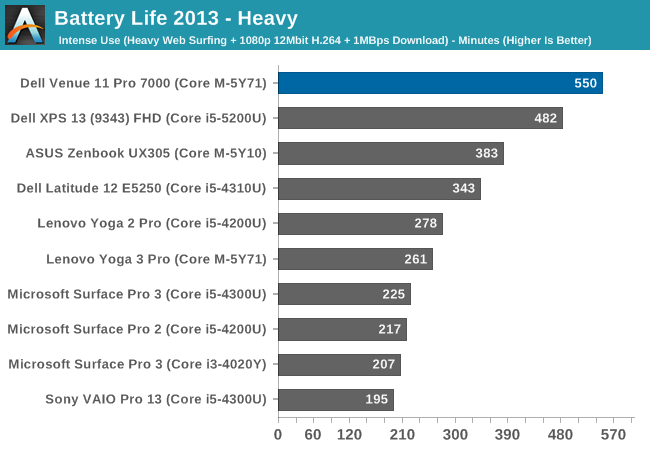
With an even larger battery than the Dell XPS 13, the same resolution display, and Core M, the Venue 11 Pro can easily deliver all-day battery life even when put through our heavy test. It is a very impressive result. 2015 seems to be the year of battery life, and the results are very much welcome.
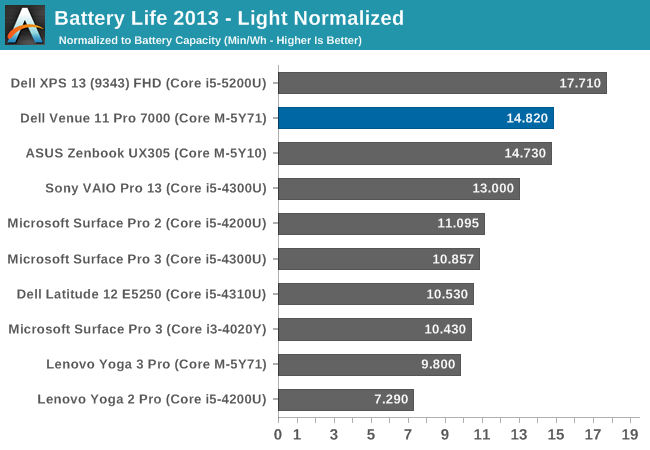

Next, the devices have the overall battery life divided by the battery capacity to give a feel for overall platform efficiency. Here the Venue 11 Pro does very well again, scoring almost at the top. As a system, the Venue 11 Pro is very efficient, and that is backed by a larger than normal battery when docked to the keyboard, which makes for a very mobile device.
Charge Time
Battery life is of course just one side of the mobile equation. The time to charge can also play a big factor especially when travelling. Dell ships the Venue 11 Pro with a 24 watt adapter, which has micro USB in order to charge both the tablet and the keyboard. This is not a huge amount of power, but it does keep the adapter on the small side to make it easier to bring with you.
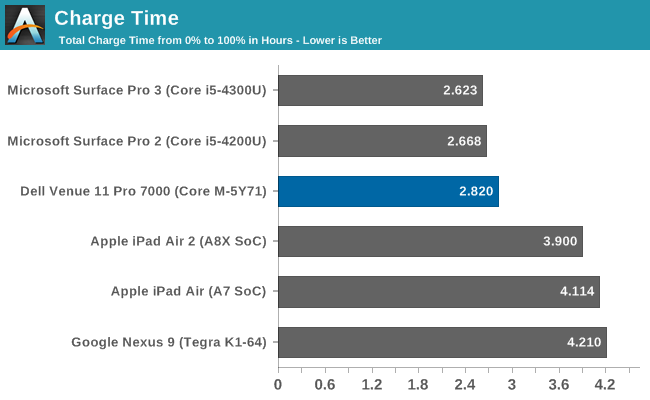
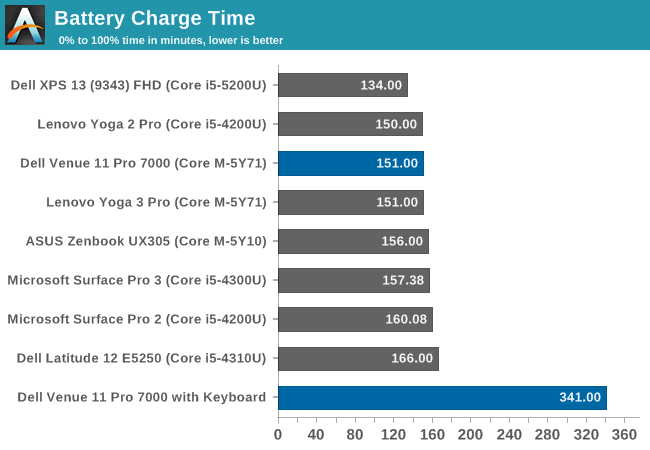
Just charging the tablet takes 2:49, which is a bit long when compared to a laptop, but a good score when compared to a tablet. It is almost the opposite of what you would expect though, since it has a small battery for a notebook, and a large battery for a tablet. So obviously Dell has made a good compromise here.
Once you add in the keyboard though, the charge times get pretty high. Charging both devices at the same time results in a 5:41 charge time, which is well over what most notebooks will do. The micro USB cable plugs into the tablet, which then charges the keyboard, at least in this scenario. I can understand why Dell has done this, but it does make for a long time to get to 100% charge. If needed, the keyboard can be charged on its own but only with the tablet detached since the charging connector is in the slot where the tablet would normally be.
Charge Rate Tablet Only
Venue 11 Pro Charge Rate with Keyboard Attachment
This graph is (at least to me) very cool. Obviously some thought has gone into how to charge the two batteries, and the priority is on the tablet battery. Once you hit 80% though, the tablet battery would normally taper off until it gets to 100%, but the second battery charges to 80% instead, and then each charges the rest of the way until the device is fully charged. The overall time could go down if both devices could charge at the same time, but that would likely require a lot more circuitry.
The docking station does include a 65 watt charger, so I hoped that this would increase the charge rate and therefore decrease the time to charge, but unfortunately this is not the case.


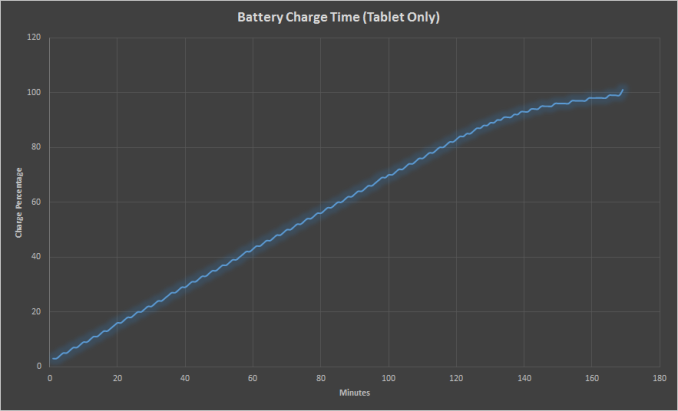
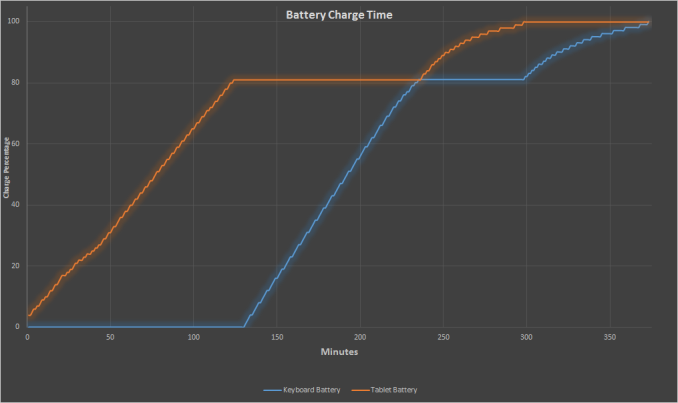








92 Comments
View All Comments
duriel - Thursday, April 16, 2015 - link
The GPU comparison looks a bit strange, since Core M does quite a bit better at 3DMark than at GfxBench. Both Manhattan and IceStorm run for a couple of minutes, so I don't buy the argument that GfxBench is slower because it runs longer (although that might be true for actual games like Dota). Perhaps it is a driver / application optimization issue. I wonder if GfxBench uses OpenGL or DirectX on Windows. Intel is generally known to have better DX drivers than OGL. Too bad we don't have more cross platform graphics benchmarks.lilmoe - Thursday, April 16, 2015 - link
I've seen other reviews around too, and I don't base my judgements on benchmarks alone. It really seams that the GPU is not up to task. How much could they mess up the driver? This isn't Intel's first attempt at iGPUs...thunng8 - Friday, April 17, 2015 - link
Ice Storm is a fair bit shorter than gfxBench benchmarks and IMO gfxBench graphically looks much better especially ManhattanShadowmaster625 - Thursday, April 16, 2015 - link
I hope they keep pushing these thigns out. When we go into the next recession these things will be all over slickdeals for $400 maybe even $300. At around $400 this is a very compelling product.chizow - Thursday, April 16, 2015 - link
I was part of the validation process for these Venue Pros and other tablet/2-in-1s for work and we decided not to use these in favor of the Surface Pro 3 mixed in with some Yoga Pros and Transformer T300s (for users who wanted more of a 2-in-1 experience).There were a number of major problems with the Venue Pro that we ran into compared to the competitors and really only one positive.
Pros: Take care of this easy one first, it has a built-in SC Reader. It works poorly, but it is there. This is an important feature for any Enterprise that does business with the Government or has the highest security standards.
Cons:
-1080p 16:9 aspect ratio is terrible for tablet portrait usage. Works OK on a smartphone because that's all we've ever known, but for web content and even most documents, 16:9 just doesn't work and often forces you to scroll LR on a page, especially if there is a menu/banner on either side.
-Heavy and thick. Just feels really heavy. Maybe its due to the stocky dimensions, but it just feels heavy in the hand and it is considerably thicker than the SP3. It feels even worst as a tablet than the original Surface Pro and Pro 2.
-Dock. Price and overall build quality on the dock is good, but attaching it is not as easy as the SP3 dock and you also can't attach the keyboard while docked like you can with the SP3's dock. Also not as many connectivity options but overall the dock is good especially for the price.
-Folio Keyboard. This thing is awful, can't even be compared to the SP3's dock and it is also unnecessarily thick due to the multiple manifolds required for its stand-up folio action. The keyboard itself feels awful, almost no key travel it is more like the touchpads that also double as buttons for your entire keyboard. Also, in "laptop" mode it just doesn't work well because the tablet is SO much heavier than the keyboard and the only support you have is the flexible folio back kickstand. If you want a 2-in-1 spring for the new rigid typepad/battery accessory or look at the Asus Transformer T300 or Yoga Pro 3.
-Probably no longer an issue with this Core M variant, but the i5 unit I had the fan would ramp up and it would get LOUD.
So yeah, would definitely check this one out in person before you buy, from my testing and time spent validating multiple of these options, I would spend a bit more and go with a Surface Pro 3 i5 variant with 4GB/128GB or 8GB/256GB or one of the higher-end Surface 3 (non-Pro). Surface Pro line is probably due for an update soon anyways, I would expect to see a Core M variant replacing the low-end i3.
Brett Howse - Thursday, April 16, 2015 - link
So just to clarify, your experience is with the older model then? Obviously this one is quiet since it is passively cooled. It's great to hear from people who have a lot of experience with these devices.chizow - Friday, April 17, 2015 - link
Yeah it was the older i5 model but I figured Core M would quiet it down which is great to hear. I did also go back and read the parts of the review on the dimensions and it does look like they addressed the thickness and weight concerns somewhat, but I am not sure they've done enough to address the 2-in-1 and screen size/aspect ratio concerns.In any case I do laud Dell for taking a chance on this segment but like the Surface Pro line, I think more iterations and improvements are needed for this product to do well.
DigitalFreak - Thursday, April 16, 2015 - link
We bought a bunch of these @ work. Absolute junk. Do yourself a favor and look at the Lenovo Helix.lilmoe - Thursday, April 16, 2015 - link
Mind sharing your experience? Was it performance or overall quality?Azurael - Thursday, April 16, 2015 - link
Was that the previous 7130 model? They launched with a shedload of issues after receiving numerous positive reviews. The screen would freeze frequently unless panel self refresh was disabled, the touch screens would register double taps constantly, the stylus was basically useless and the SSDs got laggy over time. After several BIOS updates and firmware updates for almost every component I could imagine having updateable firmware (and not just the touch controller, but the LCD panel itself) it works great. I think Dell really dropped the ball, I assume businesses had already given up on them by that point which is good for me, because refurbs are numerous and cheap :)